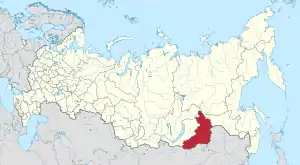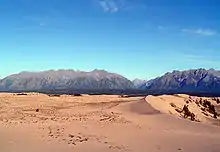Zabaykalsky Krai
Zabaykalsky Krai (Russian: Забайкальский край, tr. Zabaikal'skii krai, IPA: [zəbɐjˈkalʲskʲɪj kraj], lit. "Transbaikal krai"; Buryat: Yбэр Байгалай хизаар, romanized: Uber Baigalai Xizaar) is a federal subject of Russia (a krai) that was created on March 1, 2008 as a result of a merger of Chita Oblast and Agin-Buryat Autonomous Okrug, after a referendum held on the issue on March 11, 2007. The Krai is now part of the Russian Far East as of November 2018 in accordance with a decree issued by Russian President Vladimir Putin.[9] The administrative center of the krai is located in the city of Chita. As of the 2010 Census, the population was 1,107,107.[5]
Zabaykalsky Krai | |
|---|---|
Krai | |
| Забайкальский край | |
 Flag  Coat of arms | |
 | |
| Coordinates: 54°00′N 118°00′E | |
| Country | Russia |
| Federal district | Far Eastern[1] |
| Economic region | Far Eastern[2] |
| Administrative center | Chita |
| Government | |
| • Body | Legislative Assembly[3] |
| • Governor[3] | Aleksandr Osipov |
| Area | |
| • Total | 431,500 km2 (166,600 sq mi) |
| • Rank | 12th |
| Population (2010 Census)[5] | |
| • Total | 1,107,107 |
| • Estimate (2018)[6] | 1,072,806 (−3.1%) |
| • Rank | 47th |
| • Density | 2.6/km2 (6.6/sq mi) |
| • Urban | 65.9% |
| • Rural | 34.1% |
| Time zone | UTC+9 (MSK+6 |
| ISO 3166 code | RU-ZAB |
| License plates | 75, 80 |
| OKTMO ID | 76000000 |
| Official languages | Russian[8] |
| Website | http://www.забайкальскийкрай.рф |
Geography
The krai is located within the historical region of Transbaikalia (Dauria) and has extensive international borders with China (Inner Mongolia and Heilongjiang) (998 km) and Mongolia (Dornod Province, Khentii Province and Selenge Province) (868 km); its internal borders are with Irkutsk and Amur Oblasts, as well as with the Buryatia and the Sakha Republic. The Khentei-Daur Highlands are located at the southwestern end. The Ivan-Arakhley Lake System is a group of lakes lying west of Chita.


History
The first traces of human presence in the area dates to 35-150 thousand years ago. Early evidence was found on the surface of ancient river gravels Gyrshelunki (tributary of the Khilok River) near the city of Chita, near Ust-Menza on the Chikoy River.
Based on toponyms, Zabaykalsky might have once been inhabited by a non documented, extinct Yeniseian language.[10]
Mongolic-related Slab Grave cultural monuments are found in Baikal territory.[11] The territory of Zabaykalsky Krai has been governed by the Xiongnu Empire (209 BC-93 CE) and Mongolian Xianbei state (93-234), Rouran Khaganate (330-555), Mongol Empire (1206-1368) and Northern Yuan (1368-1691).[12] Medieval Mongol tribes like Merkit, Tayichiud, Jalairs and Khamag Mongols inhabited in the krai.[12] In the 17th century, some or all of Mongolic-speaking Daurs lived along the Shilka, upper Amur, and on the Bureya River. They thus gave their name to the region of Dauria, also called Transbaikal, now the area of Russia east of Lake Baikal. Today Buryat-Mongols remained in the territory of the krai.
Preliminary work on the unification of the Chita Oblast and Agin-Buryat Autonomous Okrug was started at the level of regional authorities in April 2006. The governor of Chita Oblast Ravil Geniatulin, mayor of the Agin-Buryat Autonomous Okrug Bair Zhamsuyev, head of the regional parliament Anatoly Romanov, and Dashi Dugarov sent a letter to the President of Russia, Vladimir Putin, and on November 17, 2006, he supported the initiative.
A referendum on unification took place on March 11, 2007. In Chita Oblast, "yes" was the predominant answer to the following question:
"Do you agree that the Chita Oblast and Agin-Buryat Autonomous Okrug merged into a new entity of the Russian Federation - Zabaykalsky Krai, which included Agin-Buryat Autonomous Okrug will be an administrative-territorial unit with special status, defined by the charter of the province in accordance with the legislation of the Russian Federation?"
In Chita Oblast, 90.29% (535,045 voters) of the voters voted for the union versus - 8.89% (52,698 voters) who voted against it. 72.82% of the electorate participated. In the Aga Buryat Autonomous Region 94% (38,814 voters) voted for the union versus - 5.16% (2129 voters). 82.95% of the electorate voters participated.
On July 23, 2007, Russian President Vladimir Putin signed a federal constitutional law "On Establishment in the Russian Federation of a new subject of the Russian Federation in the merger of Chita Oblast and Agin-Buryat Autonomous Okrug", adopted by the State Duma on July 5, 2007. and approved by the Federation Council on July 11, 2007.
Economy
Large companies in the region include the Priargunskoe Mining and Chemical Association, Territorial Generating Company №14, Novo-Shirokinsky mine, Kharanorskaya State District Power Plant, Kharanorskiy coal mine.[13]
Government
Ravil Geniatulin, the Governor of Chita Oblast, was elected Governor of Zabaykalsky Krai on February 5, 2008 by the majority of the deputies of both Chita Oblast Duma and Agin-Buryat Autonomous Okrug Duma. He assumed the post on March 1, 2008.[14] United Russia candidate Natalia Zhdanova was elected governor with 54% of the vote on September 18, 2016.[15]
Demographics
Population: 1,107,107 (2010 Census);[5] 1,155,346 (2002 Census);[16] 1,377,975 (1989 Census).[17]
According to the 2010 Census,[5] Russians made up 89.9% of the population while Buryats were 6.8%. Other significant groups were Ukrainians (0.6%), Tatars (0.5%), Armenians (0.4%), Azeris (0.2%), Kyrgyz (0.2%). 19,981 people were registered from administrative databases, and could not declare an ethnicity. It is estimated that the proportion of ethnicities in this group is the same as that of the declared group.[18]
| Ethnicity | Population | Percentage |
|---|---|---|
| Russians | 977,400 | 89.9% |
| Buryats | 73,941 | 6.8% |
| Ukrainians | 6,743 | 0.6% |
| Tatars | 5,857 | 0.5% |
| Others | 23,185 | 2.2% |
Settlements
Largest cities or towns in Zabaykalsky Krai 2010 Russian Census | |||||||||
|---|---|---|---|---|---|---|---|---|---|
| Rank | Administrative Division | Pop. | |||||||
.JPG.webp) Chita  Krasnokamensk |
1 | Chita | Chitinsky District | 324,444 | |||||
| 2 | Krasnokamensk | Krasnokamensky District | 55,666 | ||||||
| 3 | Borzya | Borzinsky District | 31,379 | ||||||
| 4 | Petrovsk-Zabaykalsky | Petrovsk-Zabaykalsky District | 18,549 | ||||||
| 5 | Nerchinsk | Nerchinsky District | 14,959 | ||||||
| 6 | Shilka | Shilkinsky District | 13,947 | ||||||
| 7 | Chernyshevsk | Chernyshevsky District | 13,359 | ||||||
| 8 | Mogocha | Mogochinsky District | 13,258 | ||||||
| 9 | Karymskoye | Karymsky District | 13,037 | ||||||
| 10 | Baley | Baleysky District | 12,533 | ||||||
- 2007
- Births: 16,652 (14.84 per 1000; 14.87 in urban areas and 14.79 in rural areas).
- Deaths: 16,186 (14.42 per 1000; 14.42 in urban areas and 14.44 in rural areas).
- Natural Growth Rate: 0.04% per year (0.05% in urban areas and 0.04% in rural areas).
- 2008
Source:[19]
- Births: 17,809 (15.9 per 1000)
- Deaths: 16,053 (14.3 per 1000)
- NGR: 0.16%
- Net Immigration: -3,621
- Vital statistics for 2012
2010 - 1.87 | 2011 - 1.87 | 2012 - 2.00 | 2013 - 2.01 | 2014 - 2.08 | 2015 - 2.06 | 2016 - 1.98 | 2017 - 1.87 | 2018 - 1.82 | 2019 - 1.74 | 2020 - 1.75
Religion
As of a 2012 survey[22] 25% of the population of Zabaykalsky Krai adheres to the Russian Orthodox Church, 6.25% to Buddhism, 6% declares to be generically unaffiliated Christian (excluding Protestant churches), 2% is an Orthodox Christian believer without belonging to any church or being member of other (non-Russian) Orthodox churches. In addition, 28% of the population declares to be "spiritual but not religious", 17% to be atheist, and 16.15% follows other religion or did not give an answer to the survey.[22]
See also
- List of Chairmen of the Legislative Assembly of Zabaikalsky Krai
References
Notes
- Президент Российской Федерации. Указ №849 от 13 мая 2000 г. «О полномочном представителе Президента Российской Федерации в федеральном округе». Вступил в силу 13 мая 2000 г. Опубликован: "Собрание законодательства РФ", No. 20, ст. 2112, 15 мая 2000 г. (President of the Russian Federation. Decree #849 of May 13, 2000 On the Plenipotentiary Representative of the President of the Russian Federation in a Federal District. Effective as of May 13, 2000.).
- Госстандарт Российской Федерации. №ОК 024-95 27 декабря 1995 г. «Общероссийский классификатор экономических регионов. 2. Экономические районы», в ред. Изменения №5/2001 ОКЭР. (Gosstandart of the Russian Federation. #OK 024-95 December 27, 1995 Russian Classification of Economic Regions. 2. Economic Regions, as amended by the Amendment #5/2001 OKER. ).
- Charter of Zabaykalsky Krai, Article 21
- Федеральная служба государственной статистики (Federal State Statistics Service) (May 21, 2004). "Территория, число районов, населённых пунктов и сельских администраций по субъектам Российской Федерации (Territory, Number of Districts, Inhabited Localities, and Rural Administration by Federal Subjects of the Russian Federation)". Всероссийская перепись населения 2002 года (All-Russia Population Census of 2002) (in Russian). Federal State Statistics Service. Retrieved November 1, 2011.
- Russian Federal State Statistics Service (2011). Всероссийская перепись населения 2010 года. Том 1 [2010 All-Russian Population Census, vol. 1]. Всероссийская перепись населения 2010 года [2010 All-Russia Population Census] (in Russian). Federal State Statistics Service.
- "26. Численность постоянного населения Российской Федерации по муниципальным образованиям на 1 января 2018 года". Federal State Statistics Service. Retrieved January 23, 2019.
- "Об исчислении времени". Официальный интернет-портал правовой информации (in Russian). June 3, 2011. Retrieved January 19, 2019.
- Official throughout the Russian Federation according to Article 68.1 of the Constitution of Russia.
- "Официальный интернет-портал правовой информации". publication.pravo.gov.ru. Retrieved November 4, 2018.
- https://scholarspace.manoa.hawaii.edu/bitstream/10125/24847/1/ldc-sp17-10-vajda.pdf
- History of Mongolia, Volume I, 2003
- History of Mongolia, Volume II, 2003
- "Trans-Baikal Territory Industries". investinregions.ru. Archived from the original on November 7, 2018. Retrieved November 7, 2018.
- На административной карте РФ появился новый субъект федерации - Забайкальский край. (A new federal subject—Zabaykalsky Krai—appeared on the administrative map of the Russian Federation) Itar-Tass.com (in Russian)
- Siberia and Russian Far East vote decisively for United Russia in parliamentary elections. (Siberia and Russian Far East vote decisively for United Russia in parliamentary elections) The Siberian Times (in English)
- Russian Federal State Statistics Service (May 21, 2004). Численность населения России, субъектов Российской Федерации в составе федеральных округов, районов, городских поселений, сельских населённых пунктов – районных центров и сельских населённых пунктов с населением 3 тысячи и более человек [Population of Russia, Its Federal Districts, Federal Subjects, Districts, Urban Localities, Rural Localities—Administrative Centers, and Rural Localities with Population of Over 3,000] (XLS). Всероссийская перепись населения 2002 года [All-Russia Population Census of 2002] (in Russian).
- Всесоюзная перепись населения 1989 г. Численность наличного населения союзных и автономных республик, автономных областей и округов, краёв, областей, районов, городских поселений и сёл-райцентров [All Union Population Census of 1989: Present Population of Union and Autonomous Republics, Autonomous Oblasts and Okrugs, Krais, Oblasts, Districts, Urban Settlements, and Villages Serving as District Administrative Centers]. Всесоюзная перепись населения 1989 года [All-Union Population Census of 1989] (in Russian). Институт демографии Национального исследовательского университета: Высшая школа экономики [Institute of Demography at the National Research University: Higher School of Economics]. 1989 – via Demoscope Weekly.
- "Впн-2010". Archived from the original on December 25, 2018. Retrieved December 22, 2011.
- "Естественное движение населения в разрезе субъектов Российской Федерации". Archived from the original on March 1, 2013. Retrieved March 31, 2013.
- "Суммарный коэффициент рождаемости". Archived from the original on April 2, 2022. Retrieved September 9, 2021.
- "Arena: Atlas of Religions and Nationalities in Russia". Sreda, 2012.
- 2012 Arena Atlas Religion Maps. "Ogonek", № 34 (5243), 27/08/2012. Retrieved 21/04/2017. Archived.
Sources
- Законодательное Собрание Забайкальского края. Закон №125-ЗЗК от 17 февраля 2009 г. «Устав Забайкальского края», в ред. Закона №1307-ЗЗК от 25 марта 2016 г «О внесении изменения в статью 52 Устава Забайкальского края». Вступил в силу через десять дней после дня официального опубликования. Опубликован: "Забайкальский рабочий", №30, 18 февраля 2009 г. (Legislative Assembly of Zabaykalsky Krai. Law #125-ZZK of February 17, 2009 Charter of Zabaykalsky Krai, as amended by the Law #1307-ZZK of March 25, 2016 On Amending Article 52 of the Charter of Zabaykalsky Krai. Effective as of the day which is ten days after the day of the official publication.).
- Федеральный конституционный закон №5-ФКЗ от 21 июля 2007 г. «Об образовании в составе Российской Федерации нового субъекта Российской Федерации в результате объединения Читинской области и Агинского-Бурятского автономного округа». (Federal Constitutional Law #5-FKZ of July 21, 2007 On the Establishment Within the Russian Federation of a New Federal Subject of the Russian Federation as a Result of the Merger of Chita Oblast and Agin-Buryat Autonomous Okrug. ).